Nortec GS User Manual
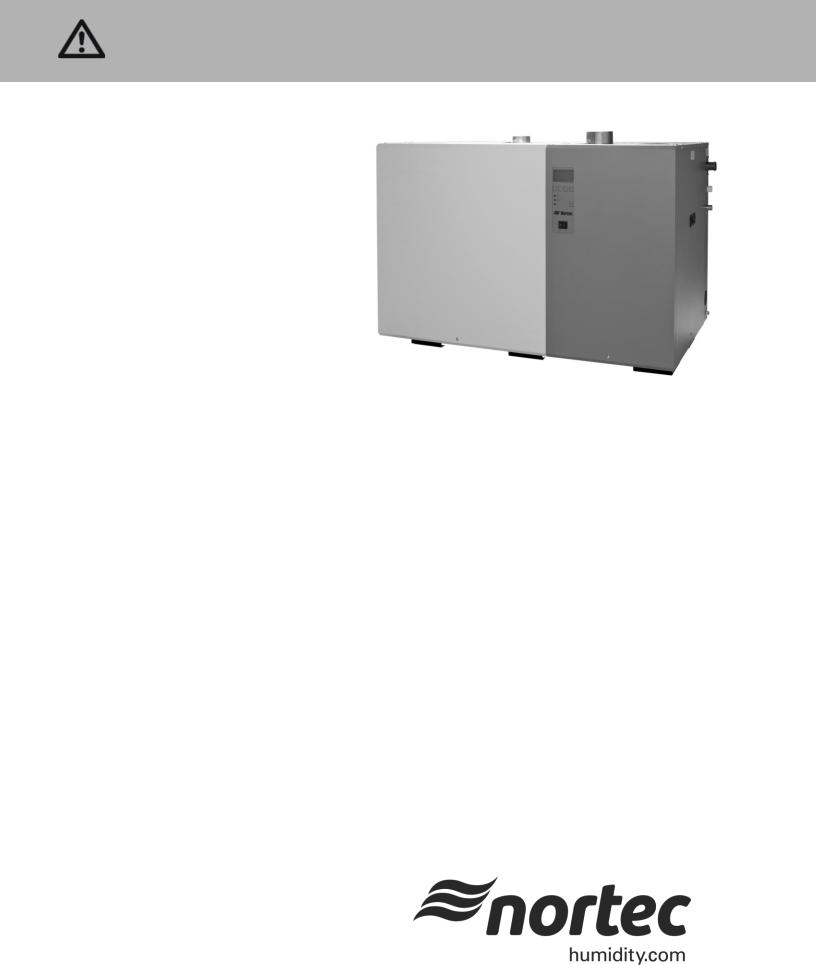
Important: Read and save these instructions. This guide to be left with equipment.
 GS Series
GS Series
Installation and Operation Manual
Includes installation, operation, maintenance, and troubleshooting information for your GSTC / GHP gas steam humidifier.
1506222-L| 07 JAN 2014
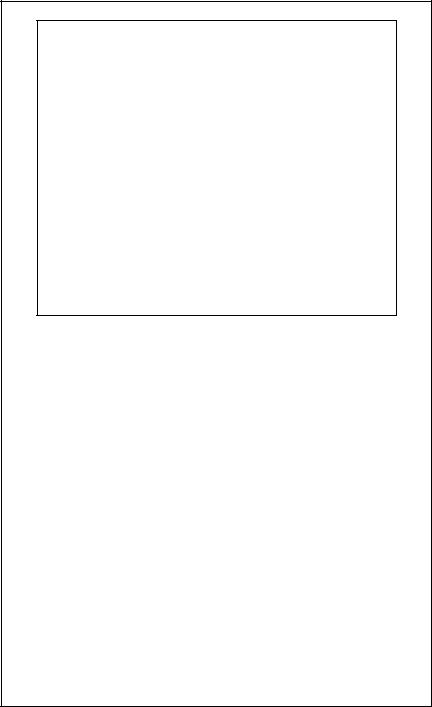
 WARNING:
WARNING:
FIRE OR EXPLOSION HAZARD
Failure to follow safety warnings exactly could result in serious injury, death or property damage.
Be sure to read and understand the installation, operation and service instructions in this manual.
Improper installation, adjustment, alteration, service or maintenance can cause serious injury, death or property damage.
−Do not store or use gasoline or other flammable vapors and liquids in the vicinity of this or any other appliance.
−WHAT TO DO IF YOU SMELL GAS
Do not try to light any appliance.
Do not touch any electrical switch; do not use any phone in your building.
Leave the building immediately.
Immediately call your gas supplier from a phone remote from the building. Follow the gas supplier’s instructions.
If you cannot reach your gas supplier, call the fire department.
−Installation and service must be performed by a qualified installer, service agency or the gas supplier.

Thank you for choosing Nortec.
INSTALLATION DATE (MM/DD/YYYY)
MODEL #
SERIAL #
Proprietary Notice
This document and the information disclosed herein are proprietary data of Nortec Humidity Ltd. Neither this document nor the information contained herein shall be reproduced used, or disclosed to others without the written authorization of Nortec Humidity Ltd., except to the extent required for installation or maintenance of recipient’s equipment. All references to the Nortec name should be taken as referring to Nortec Humidity Ltd.
Liability Notice
Nortec does not accept any liability for installations of humidity equipment installed by unqualified personnel or the use of parts/components/equipment that are not authorized or approved by Nortec.
Copyright Notice
Copyright 2014 Nortec Humidity Ltd. All rights reserved.

Contents
4 |
General |
7 |
Installation |
7 |
Indoor Installation |
7 |
Locating and Mounting |
9 |
Gas Piping |
11 |
Combustion Air Requirements |
12 |
Exhaust Venting |
17Installation As A Category I Appliance
18Installation As A Category III Appliance
20 Electrical
25 Plumbing
28 Outdoor Installation
35Operation
36Start-Up Procedure
38 Taking out of Operation
41 Scale Management
43Fault Conditions
44Maintenance
44 Draining the Tank
46Cleaning the Steel Tank
47Servicing the Unit
49 Component Replacement
55 Key Pad
73 Troubleshooting
80Wiring Diagrams & Spare Parts
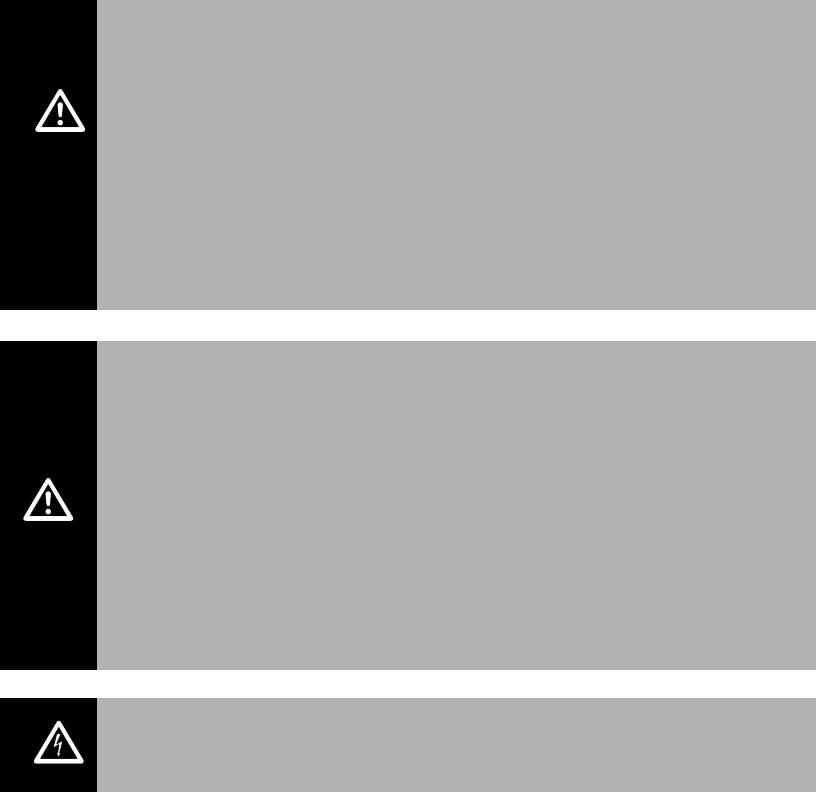
Introduction
CAUTION: General
The Nortec GS series must be kept clear and free of combustible materials, gasoline, and other flammable vapors and liquids.
The indoor GS humidifier located in an insulated space must be kept free and clear of insulating material. Do not add combustible insulating material to the appliance.
The GS humidifier requires proper ducting for combustion air and exhaust ventilation for safe operation. Avoid blocking or obstructing air openings on the appliance, air openings communicating with the area in which the appliance is installed and the spacing around the appliance.
Should overheating occur, or the gas supply fails to shutoff, shut off the manual gas valve to the appliance before switching off the electrical supply.
Do not use this appliance if any part has been under water. Immediately call a qualified service technician to inspect the appliance and to replace any part of the control system and any gas control which has been under water.
CAUTION: Servicing
Nortec does not accept any liability for installations of humidity equipment installed by unqualified personnel or the use of parts/components/equipment that are not authorized or approved by Nortec.
Every person working with the Nortec GS Series must read and understand the installation and operating instructions before carrying out any work.
Disconnect main power and shut off gas supply before any servicing.
During and following operation of the humidifier, the steam and components in contact with the steam can become hot and burn if touched.
Poorly maintained humidifiers can endanger health of building occupants.
The GS must be serviced in the intervals described in the maintenance section of this manual.
Be mindful of weather. Opening a GSTC Outdoor enclosure exposes internal components that should not come into contact with water. It is not recommended to perform ay service on an Outdoor GSTC during rain, snow, sleep or hail.
CAUTION: Electrical
All electrical work should be done according to local electrical code.
Electrical connection to be performed by a licensed electrician.
GS Series Installation | 2
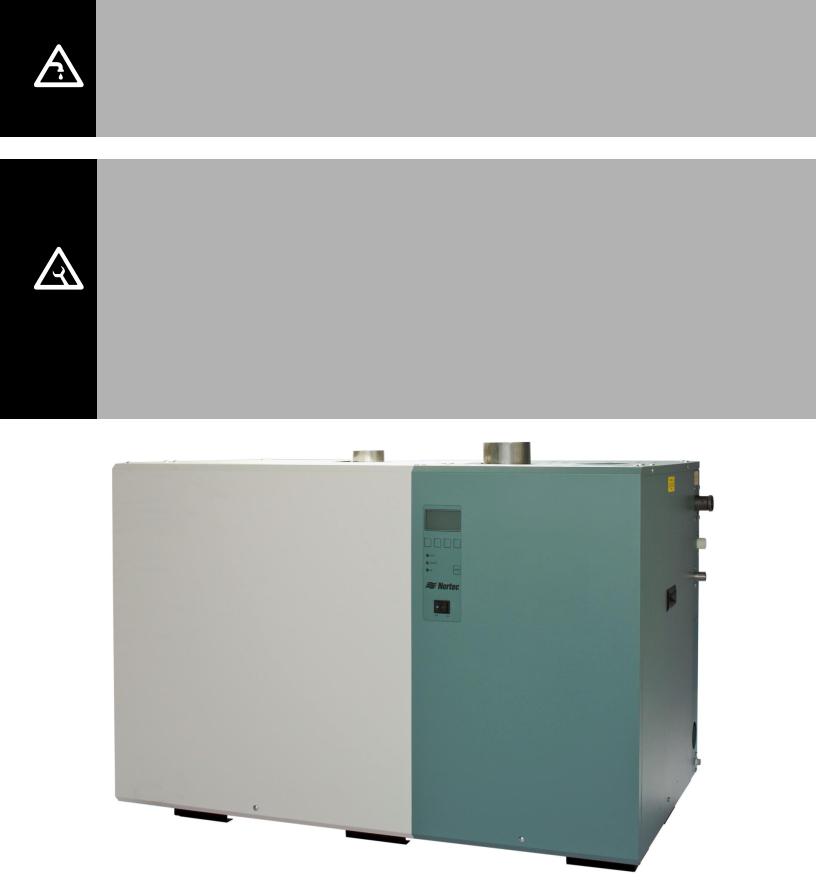
CAUTION: Plumbing
Plumbing to be performed by a licensed plumber.
All plumbing work should be done according to local plumbing code.
Unit damage caused by water quality outside of the specified ranges is not covered under warranty.
CAUTION: Installation
Installation and service must be performed by a qualified installer, service agency or the gas supplier
The GS produces steam at atmospheric pressure. No devices which could block steam output should be connected to the steam outlet.
Steam lines must be installed so that no restriction can produce backpressure in the humidifier. Failure to follow installation instructions will result in improper operation and could void warranty.
Regardless of selecting On/Off or modulating control method, Nortec humidifiers must have a closed circuit across its On/Off security loop control terminal to operate. Nortec highly recommends the use of a high limit humidistat and an air proving switch in series for this function.
Figure 1: GSTC-100
3 | GS Series Installation
General
This installation guide has been designed to provide assistance when installing, mounting, and commissioning a GS Series humidifier. Actual on site application may vary. Consult Technical Services or your local Nortec representative.
Warning
Improper installation, adjustment, alteration, service, maintenance, or use can cause carbon monoxide poisoning, an explosion, fire, electrical shock, or other conditions which may cause personal injury or property damage. Consult a qualified installer, service agency, local gas supplier, distributor, or branch for information or assistance. The qualified installer or agency must use only factory authorized and listed kits or accessories when modifying this product. A failure to follow this warning can cause electrical shock, fire, personal injury, or death.
Should overheating occur, or the gas fails to shut off, shut off the manual gas valve to the appliance before shutting off the electrical supply.
Do not use this appliance if any part has been under water. Immediately call a qualified service technician to inspect the appliance and to replace any part of the control system and any gas control which has been under water.
Delivery
The standard delivery includes:
Gas Steam humidifier equipped with desired options.
In a bag you will find: o Manuals.
o Adapter fittings for water connection.
o Steam hose for steam outlet with clamps.
o Hose and clamps for drain connection.
The GS Indoor Series offers an optional telescopic stand mounted inside the unit legs. Stand cross bracing are shipped with the unit.
The GS Outdoor Series comes with all required venting to be installed on site. Desired accessories ordered.
Receiving And Unpacking Equipment
Check packing slip to ensure ALL material has been delivered.
All material shortages are to be reported to Nortec within 48 hours from receipt of goods. Nortec assumes no responsibility for any material shortages beyond this period.
Inspect shipping boxes for damage and note on shipping waybill accordingly.
After unpacking, inspect equipment for damage and if damage is found, notify the shipper promptly.
All Nortec products are shipped on an F.O.B. factory basis. Any and all damage, breakage or loss claims are to be made directly to the shipping company.
GS Series Installation | 4
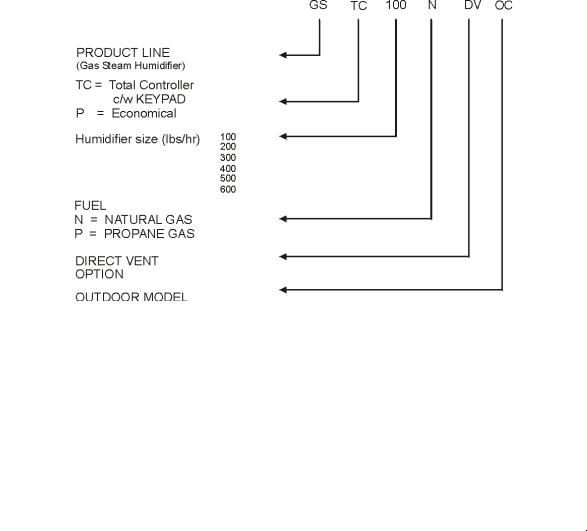
General Specifications
The Nortec GS Series humidifier is a completely new patented design based on leading edge technology. The GS is designed to provide clean steam humidification at an economical price.
The GS Series humidifiers are designed exclusively for humidification in ventilation systems or direct room humidification. Any other type of application, without the written consent of Nortec or your Nortec agent, is considered as not conforming to the intended purposes. The manufacturer/supplier cannot be made liable for any damages resulting from improper use.
Model Designation
The unit specification label indicates the model of gas humidifier according to Figure 2.
Figure 2: Model Designation
High Altitude
A derate in input exists for installations at higher altitudes. For Canadian models, an automatic 10% derate applies to installations from 2000-4500 feet. For U.S. Models, refer to the chart below for high altitudes derate information.
|
|
|
|
|
Table 1: High Altitude |
|
|
|
|
|
|
|
|
|
|
|
|
|
|
|
|
|
|
Altitude |
|
|
|
|
|
|||
|
|
|
|
|
|
|
|
|
Derate % |
|
|
Feet |
|
|
|
Meters |
|
|
|
|
|
|
|
|
|
|
|
|
|
|
||
|
|
|
|
|
|
|
|
|
|
|
0-2000 |
|
|
0-610 |
|
|
0 |
|
|||
|
|
|
|
|
|
|
|
|||
2001-3000 |
|
|
610-915 |
|
|
8 |
|
|||
|
|
|
|
|
|
|
|
|||
3001-4000 |
|
|
915-1220 |
|
|
12 |
|
|||
|
|
|
|
|
|
|
|
|||
4001-4500 |
|
|
1220-1370 |
|
|
16 |
|
|||
|
|
|
|
|
|
|
|
|
||
|
4501-higher |
|
|
|
1370-higher |
|
|
Contact Factory |
||
|
|
|
|
|
|
|
|
|
|
|
5 | GS Series Installation

Table 2: Model Specification
MODEL GS 100 SPECIFICATIONS
FUEL |
BLOWER SPEED |
INPUT (BTUH) |
STEAM CAPACITY (LBS/HR) |
MANIFOLD PRESS. IN W.C. |
|
|
MAX |
140,000 |
105 |
-0.05 |
|
|
NATURAL GAS |
|
|
|
|
|
MIN |
45,000 |
25 |
-0.05 |
|
||
|
|
|
||||
|
|
|
|
|
|
|
|
|
MAX |
140,000 |
105 |
-0.35 |
|
|
PROPANE |
|
|
|
|
|
MIN |
50,000 |
25 |
-0.35 |
|
||
|
|
|
||||
|
|
|
|
|
|
|
|
|
|
|
|
|
|
|
|
|
MODEL GS 200 SPECIFICATIONS |
|
|
|
|
|
|
|
|
|
|
|
FUEL |
BLOWER SPEED |
INPUT (BTUH) |
STEAM CAPACITY (LBS/HR) |
MANIFOLD PRESS. IN W.C. |
|
|
|
|
|
|
|
|
|
|
MAX |
280,000 |
210 |
-0.05 |
|
|
NATURAL GAS |
|
|
|
|
|
|
MIN |
45,000 |
25 |
-0.05 |
|
|
|
|
|
||||
|
|
|
|
|
|
|
|
|
MAX |
280,000 |
210 |
-0.35 |
|
|
PROPANE |
|
|
|
|
|
|
MIN |
50,000 |
25 |
-0.35 |
|
|
|
|
|
||||
|
|
|
|
|
|
|
|
|
|
|
|
|
|
|
|
|
MODEL GS 300 SPECIFICATIONS |
|
|
|
|
|
|
|
|
|
|
|
FUEL |
BLOWER SPEED |
INPUT (BTUH) |
STEAM CAPACITY (LBS/HR) |
MANIFOLD PRESS. IN W.C. |
|
|
|
|
|
|
|
|
|
|
MAX |
420,000 |
315 |
-0.05 |
|
|
NATURAL GAS |
|
|
|
|
|
|
MIN |
45,000 |
25 |
-0.05 |
|
|
|
|
|
||||
|
|
|
|
|
|
|
|
|
MAX |
420,000 |
315 |
-0.35 |
|
|
PROPANE |
|
|
|
|
|
|
MIN |
50,000 |
25 |
-0.35 |
|
|
|
|
|
||||
|
|
|
|
|
|
|
|
|
|
|
|
|
|
|
|
|
MODEL GS 400 SPECIFICATIONS |
|
|
|
|
|
|
|
|
|
|
|
FUEL |
BLOWER SPEED |
INPUT (BTUH) |
STEAM CAPACITY (LBS/HR) |
MANIFOLD PRESS. IN W.C. |
|
|
|
|
|
|
|
|
|
|
MAX |
560,000 |
420 |
-0.05 |
|
|
NATURAL GAS |
|
|
|
|
|
|
MIN |
45,000 |
25 |
-0.05 |
|
|
|
|
|
||||
|
|
|
|
|
|
|
|
|
MAX |
560,000 |
420 |
-0.35 |
|
|
PROPANE |
|
|
|
|
|
|
MIN |
50,000 |
25 |
-0.35 |
|
|
|
|
|
||||
|
|
|
|
|
|
|
|
|
|
|
|
|
|
|
|
|
MODEL GS 500 SPECIFICATIONS |
|
|
|
|
|
|
|
|
|
|
|
FUEL |
BLOWER SPEED |
INPUT (BTUH) |
STEAM CAPACITY (LBS/HR) |
MANIFOLD PRESS. IN W.C. |
|
|
|
|
|
|
|
|
|
|
MAX |
700,000 |
525 |
-0.05 |
|
|
NATURAL GAS |
|
|
|
|
|
|
MIN |
45,000 |
25 |
-0.05 |
|
|
|
|
|
||||
|
|
|
|
|
|
|
|
|
MAX |
700,000 |
525 |
-0.35 |
|
|
PROPANE |
|
|
|
|
|
|
MIN |
50,000 |
25 |
-0.35 |
|
|
|
|
|
||||
|
|
|
|
|
|
|
|
|
|
|
|
|
|
|
|
|
MODEL GS 600 SPECIFICATIONS |
|
|
|
|
|
|
|
|
|
|
|
FUEL |
BLOWER SPEED |
INPUT (BTUH) |
STEAM CAPACITY (LBS/HR) |
MANIFOLD PRESS. IN W.C. |
|
|
|
|
|
|
|
|
|
|
MAX |
840,000 |
630 |
-0.05 |
|
|
NATURAL GAS |
|
|
|
|
|
|
MIN |
45,000 |
25 |
-0.05 |
|
|
|
|
|
||||
|
|
|
|
|
|
|
|
|
MAX |
840,000 |
630 |
-0.35 |
|
|
PROPANE |
|
|
|
|
|
|
MIN |
50,000 |
25 |
-0.35 |
|
|
|
|
|
||||
|
|
|
|
|
|
|
GS Series Installation | 6
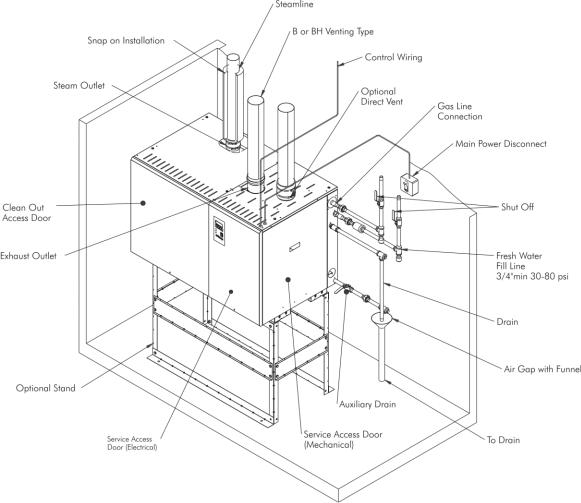
Installation
Figure 3: Typical Installation Indoor
Indoor Installation
The installation must conform with local building codes or, in the absence of local codes, with the ANSI Z223.1, National Fuel Gas Code, and/or CSA B149.1installation codes. Refer to the Gas Piping section of this manual.
Locating and Mounting
GS Series humidifiers are designed for floor mounting or on a GS stand (optional). The clearance dimensions shown in this manual are for reference only and are the minimum required for maintenance of the humidifier. Local and national codes should be consulted prior to final location and installation of the humidifier. Nortec cannot accept responsibility for installation code violations.
Figure 3 shows a typical installation with all required connections to the GS humidifier. Careful consideration should be given to all of these connections when choosing a location for the humidifier.
7 | GS Series Installation
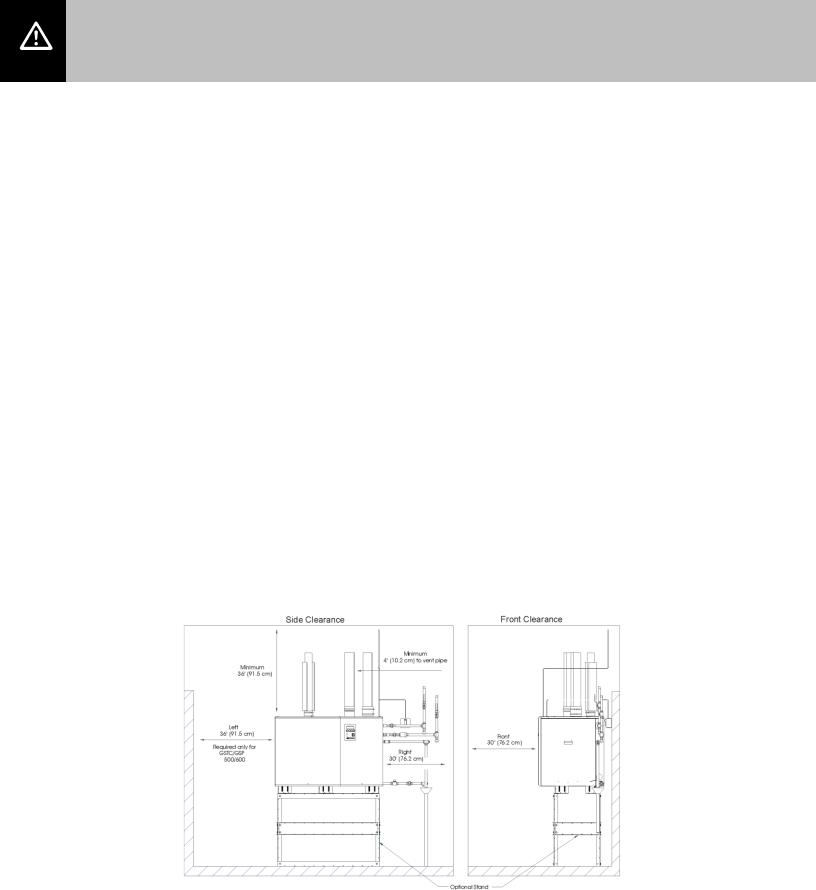
Warning:
Steam distributor on the built-on and remote mounted blower packs have a hot surface that could result in burns if touched. Nortec recommends mounting at least 8 feet above the floor.
Ambient temperature location for humidifier: 41ºF - 104ºF (5ºC - 40ºC). Relative humidity location for humidifiers: 5% rh - 80% rh.
All GS humidifiers are rated for the clearance to shown in Figure 4.
Location of the steam distributor should be minimum of 36” above the humidifier.
Do not locate humidifier any further than absolutely necessary from steam distributor location. Net output will be reduced as a result of heat loss through steam line. Also, increased static pressure (over 12" W.C.) will result in hot water going down the drain. Consult factory if this situation occurs.
Where possible, mount humidifier at a height convenient for servicing. Make sure the humidifier is mounted level.
Do not mount humidifier on hot surfaces.
The humidifier must be installed so that all electrical components are protected from exposure to water. Do not mount humidifiers in an area where freezing may occur.
If humidifiers are mounted outdoors, a properly ventilated, temperature controlled, (above freezing), weatherproof enclosure must be used.
Do not mount humidifiers on vibrating surface.
The humidifier shall not be installed directly on carpeting, tile or other combustible material other than wood flooring.
Some insulating materials may be combustible. Prior to installing this appliance examine the area for insulating material. If this appliance is installed in an insulated space, it must be kept free and clear of insulating materials. If insulation is added after the appliance is installed, it will be necessary to examine the area again.
Figure 4: Mounting Clearances
GS Series Installation | 8

Gas Piping
Installation of piping must be in accordance with local codes, and ANSI Z233.1, “National Fuel Gas Code,” in the United States or CSA B149.1 installation codes in Canada.
The following table indicates the maximum and minimum allowable gas pressures for the gas humidifier.
|
|
|
Table 3: Max & Min Gas Pressure |
|
||
|
|
|
|
|
|
|
|
|
|
Inches w.c. |
|
||
|
|
|
|
|
|
|
Gas |
|
Min |
|
|
Max |
|
|
|
|
|
|
|
|
|
Natural |
|
4.5 |
|
|
9.0 |
|
|
|
|
|
|
|
|
Propane |
|
9.0 |
|
|
13.0 |
|
|
|
|
|
|
|
The gas inlet pipe size to the appliance is:
½” NPT for GS 100 ¾” NPT for GS 200
1” NPT for GS 300 / 400 1 ¼” NPT for GS 500 / 600
Provide an adequate size gas supply line.
In all installations, a certified manual shut off valve, located outside the cabinet, must be installed. When black iron gas pipe is used, a sediment trap must be located ahead of the humidifier gas controls. See Figure 5: Gas Connection.
Leak test all gas connections external to the humidifier, using a commercial soap solution made to detect leaks. Bubbles indicate gas leakage. Seal all leaks before placing the humidifier in operation.
Warning:
Never use an open flame to check for gas leaks. If a leak does exist, a fire or explosion could occur, resulting in damage, injury or death.
The appliance and its individual shut-off valve must be disconnected from the gas supply piping system during any pressure testing of that system at test pressures equal to or greater than 14” w.c. (3.5 kPa).
The appliance must be isolated from the gas supply piping system by closing its individual manual shut-off valve during any pressure testing of the gas supply piping system at test pressures equal or less than 14” w.c. (3.5 kPa).
Dissipate test pressure from the gas supply line before re-opening the manual shut off valve to the appliance.
9 | GS Series Installation
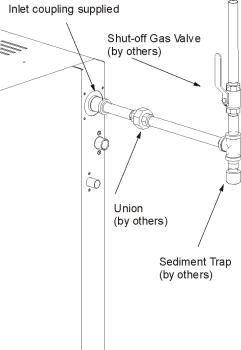
Figure 5: Gas Connection
Failure to follow this procedure may damage the gas valve. Over pressured gas valves are not covered by warranty.
Do not use Teflon tape on gas line pipe threads. A flexible sealant suitable for use with natural gas and propane gas is recommended.
Plan gas supply piping so that it will not interfere with removal of gas valves, blower assemblies, and front or side service doors.
All gas piping should be adequately supported to prevent any strain on inlet piping.
The gas valve is provided with pressure taps to measure gas pressure upstream and downstream, (manifold pressure). The minimum gas pressure shown is for the purpose of input adjustment.
A 1/8" NPT plugged tapping, accessible for test gage connection, must be installed immediately upstream of the gas supply connection to the appliance.
GS Series Installation | 10

Combustion Air Requirements
General
Provide for adequate combustion and ventilation air in accordance with sections 5.3, air for combustion and ventilation, of the national fuel gas code, ANSI z223.1, or sections 7.2, 7.3, 7.4 of CSA B149.1 installation codes, or applicable provisions of the local building codes.
The required free area of supply air opening is:
13 in. Sq. (8,387 mm2), for GS 100
23 in. Sq. (14,839 mm2), for GS 200
35 in. Sq. (22,581 mm2), for GS 300
47 in. Sq. (30,323 mm2), for GS 400
59 in. Sq. (38,064 mm2), for GS 500
71 in. Sq. (45,806 mm2), for GS 600
Cabinet top and bottom contain air openings to provide combustion air to the forced draft blower. Do not block these openings.
Excessive exposure to contaminated combustion air will result in safety and performance related problems. Known contaminates include halogens, ammonia, and chlorides, excessive dust, lime or dirt. Excessive exposure of electronics to the contaminants will also result in performance related problems. Contact nortec technical services if you have any questions. If contaminants exist, isolate the unit from the contaminated space.
Sealed Combustion Guidelines
Installation of the combustion air supply line must be carried out by adequately qualified personnel. All local regulations relating to the provision of air supply systems must be observed and adhered to.
The air supply line and the exhaust must individually not exceed a respective equivalent length of 70 ft. (21 m). The vent pipe diameter must be maintained over the overall length of the vent.
The air supply line should be approximately as long as the flue gas venting and must be supported at every 5 ft. (1.5 m) and additionally at every pipe bend. At low temperatures, water condensation can form on the outside of the pipe. To prevent this, it is recommended that the supply air line is insulated and an in line heat is added. Consult factory.
Attach the air supply line to the manifold using a hose clamp or hose coupling if required. See Figure 6.
The air intake terminal and the flue gas terminal must end at an outside location. See Figure 8: Location of air intake and glue gas terminal must comply with all local and national regulations.
Warning:
Air supply line should not obstruct any services going to the humidifier front and right side cabinet panels.
11 | GS Series Installation
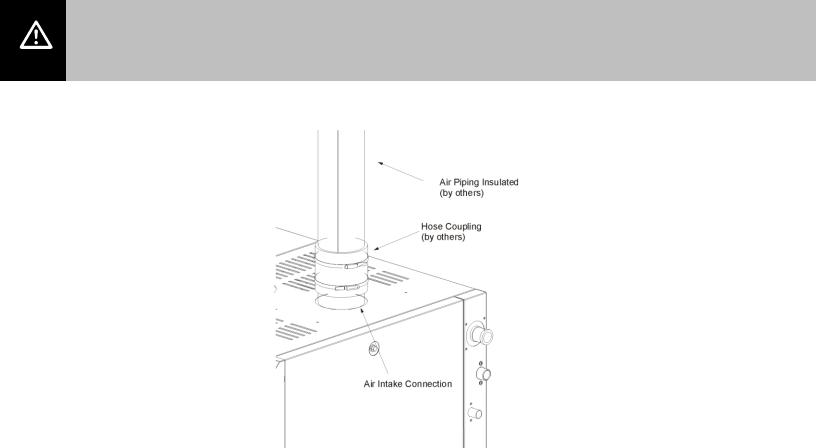
Direct Vent Guidelines
Follow “sealed combustion guidelines”
All air piping must be listed type for direct vent application with sealed joints and seams, such as z flex. The air supply line must be installed with air supply terminals provided.
Air hookup may be in plastic provided that it has fully sealed joints per CSA requirements.
Warning:
Horizontal BH type venting must be used in a direct vent application.
Figure 6: Sealed Combustion and Direct Vent Connection
Exhaust Venting
General
The GSTC and GSP are classed category I and III fan assisted gas appliances. This allows two methods of venting. Listed below are instructions for both venting systems, followed by specific requirements for each system.
Review the requirements for both category I and III installations and select the venting method best suited for the installation.
The maximum flue temperature is 400ºF for category I and category III installations. Normal operating range is 360 to 380ºF.
Category I and III class can be used with sealed combustion option Category III class must be used with direct vent option.
GS Series Installation | 12
General Requirements
The vent systems shall be listed to UL or UL/CSA standard and meet the installation requirements of the national fuel code in the USA (ANSI z223.1) and the Canadian standards CSA B149.1 installation codes. Any local jurisdictions reflecting changes to the above codes should be observed.
In applying the codes, reference should be given to the venting manufactures instructions, the serving gas supplier regulations, and the specific instructions provided in this manual.
This appliance must be installed to comply with national regulations and codes. A qualified technician, competent with these codes and the local requirements of the jurisdiction must carry out the installation.
Proper removal of combustion gases must be assured, and building materials must be protected from degradation by flue gases.
Never mix venting types (B to BH or vice versa.) Never use two different manufacturer’s equipment for the same chimney.
All vent runs should be as direct as possible with no more than 6 elbows in the system. Maintain an upward slope of ¼” per ft on all horizontal vent pipe runs.
This appliance shall not be connected to a chimney flue servicing a separate appliance designed to burn solid fuel.
This appliance may not be used in conjunction with a power venter or draft inducer.
For any vent lengths over 20 feet long, insulate the vent pipe to reduce the amount of condensate that could form in the flue gases.
When the venting passes through a cold area or location that has large amounts of air passing over the venting, it should be insulated to prevent condensation from forming inside the venting.
Vent pipe passing through walls, floors, and ceilings, must be installed with the proper clearances from combustible materials, and venting manufactures fire stop equipment.
The venting shall not pass through any circulation air duct or plenum.
A drip “t” should be used for condensate removal. When a condensate drain is used it will be necessary to install a trap to prevent flue gases from escaping. Install a trap with a minimum 12” standing water column.
Prior to activating the appliance, ensure that the trap is filled with water and that the drain terminates in accordance with local plumbing codes.
Never vent into an unlined masonry or concrete chimney unless the chimney is sized and installed according to the provisions of the national fuel code in the USA (ANSI z223.1) or the Canadian standards CSA B149.
Chimney or vent should extend at least 3’ (1 m) above a roof and at least 2’ (.6 m) above any ridge within 10’ (3 m) of the chimney. Local codes apply.
Install venting so as to prevent accumulation of condensate and have a means for condensate removal. Plastic, PVC, CPVC and HTPV special gas vents are not approved for use with this appliance.
Select vent material and clearance according to the max vent gas temperature.
All horizontal runs must be adequately supported with hangers or straps to prevent sagging.
The vent must terminate at a sufficient height above the roof to prevent blockage by expected snowfall.
13 | GS Series Installation
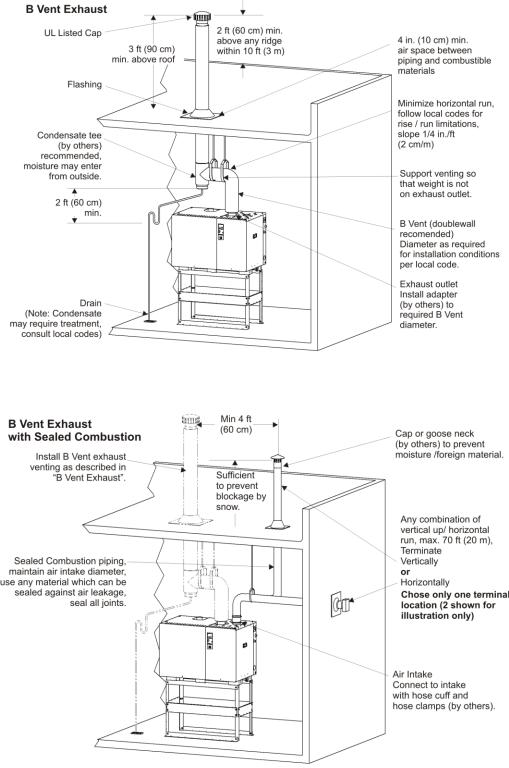
Figure 7: Vertical Venting Using B Type
Figure 8: Vertical Venting Using B Type with Sealed Combustion
GS Series Installation | 14
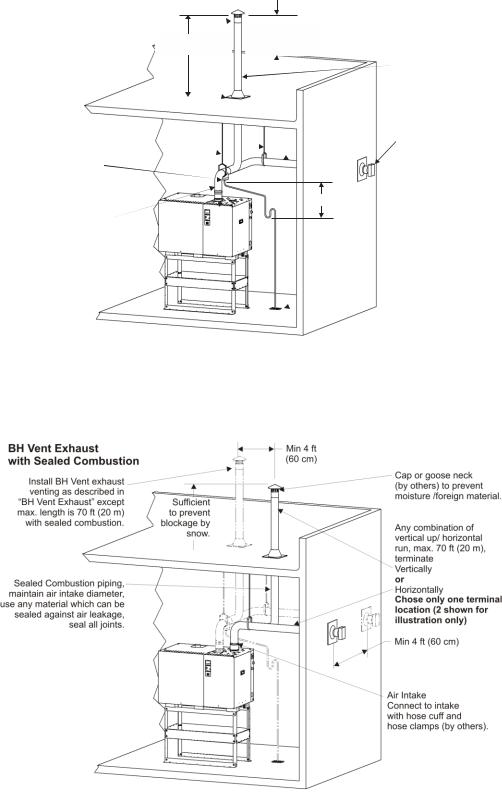
BH Vent Exhaust
UL Listed Cap (by others)
Flashing, 4 in. (10 cm) min. air space between
piping and combustible materials
Support venting so that weight is not on exhaust outlet.
Condensate tee (by others) within 2 ft (60 cm) of unit.
BH Vent Maintain diameter of exhaust outlet, any combination of
vertical up / horizontal run, max 100 ft (30 m), slope 1/4 in./ft (2 cm/m).
|
2 ft (60 cm) min. |
|
3 ft (90 cm) |
above any ridge |
|
min. above roof |
within 10 ft (3 m) |
|
|
|
|
|
|
|
2 ft (30 cm) min.
Terminate
Vertically or
Horizontally
Chose only one terminal location (2 shown for illustration only)
Horizontal exhaust terminal must be certified and can be ordered from Nortec. If BH venting used, orient vertically, 6 in from wall.
Exhaust outlet Install male to male adapter (by others).
Drain
(Note: Condensate may require treatment, consult local codes)
Figure 9: Vertical and Horizontal Venting Using BH Type
Figure 10: Vertical and Horizontal Venting Using BG Type With Sealed Combustion
15 | GS Series Installation
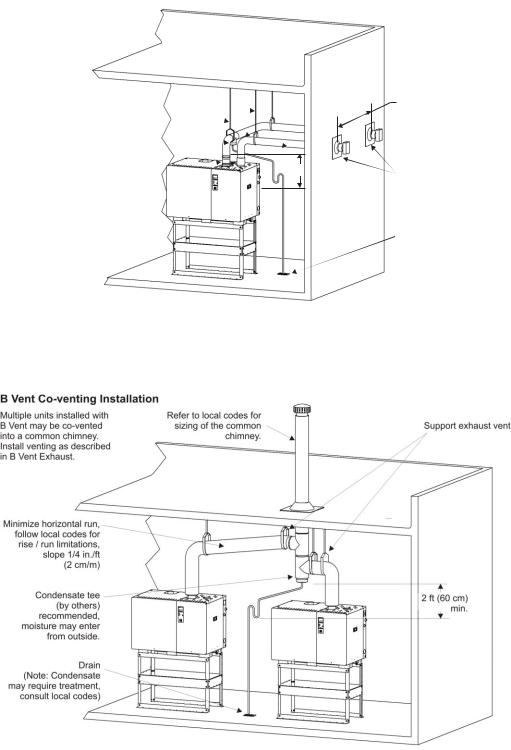
Direct Vent Installation
Direct Vent may only be installed with horizontal BH Venting and with horizontal exhaust and air
intake termination as shown.
Support exhaust and air intake lines.
Condensate tee (by others) within 2 ft (60 cm) of unit.
Exhaust outlet  Install male to male
Install male to male
adapter (by others).
Air Intake Connect to intake with hose cuff and hose clamps (by others).
2 ft (30 cm) min.
Use BH Vent for exhaust and direct vent air intake.
-Maintain diameter of exhaust outlet and intake.
-seal joints to meet CSA 2.19.7,
-any combination of vertical up / horizontal run,
-max 70 ft (20 m),
-slope 1/4 in./ft (2 cm/m).
Min 4 ft (1.2 m), max 6 ft (1.8 m)
Terminate exhaust and intake horizontally only in same face of building.
-Install Nortec or by other certified terminals
-orient vertically,
-6 in from wall.
Drain
(Note: Condensate may require treatment, consult local codes)
Figure 11: Direct Vent Installation
Figure 12: Vertical Co-Venting Using B Type
GS Series Installation | 16
Installation As A Category I Appliance
General
The GS Series humidifiers have a fan-assisted combustion which operates with a non-positive vent static pressure when installed with the appropriate vent diameter.
Category I appliances must be vented vertically or nearly vertical (see Figure 7, 8, 9, 10 & 11).
This category appliance is restricted to vertical venting installations with limits placed on horizontal lengths and vent diameters. Refer to the tables in local and/or national codes. No sidewall termination is accepted.
Vent piping must be UL or UL/CSA listed Type B. Required clearance for Type B vent is piping is 1” (25 mm).
A minimum equivalent vent length of 7 feet must be connected to the humidifier. Vent lengths must not exceed 70’ (21 m). Each 90° elbow is equivalent to 10’ and each 45° elbow equals 5'. The vent run should be as direct as possible with no more than 6 elbows in the system. Contact Nortec Technical Services if you have any questions.
The vent pipe exiting the humidifier is sized for category III installations. A field supplied adapter is required to increase the pipe immediately at the exit of the humidifier. The vent pipe must be expanded to the minimum sizes listed below for each model, increasing as code requires.
GS 100 |
4” minimum diameter |
GS 200 |
5” |
GS 300/400 |
7” |
GS 500/600 |
8” |
The termination at the humidifier is a male connection. Standard venting hook-ups require a female path. It is highly recommended that a female to female adapter be assembled onto the humidifier to establish the proper venting sequence. Consult with the venting manufacturer for proper hook up.
Vent connectors shall not be connected into any portion of a mechanical draft system operating under positive pressure.
Use only double wall (aluminum inner wall) b vent. Single wall venting cannot be used due to the increased wet time in the lining. If the vent connector attaches to a lined masonry chimney, the chimney must be sized and installed according to the provisions of the national fuel gas code or Canadian CSA B149.1 standards. An approved venting manufacturer’s termination cap for the stack outlet must be used.
When the category I installation is selected it may be commonly vented with other listed gas fire appliances. Total input rates of all appliances will determine the vent size the chimney must be sized and installed according to the provisions of the national fuel gas code or Canadian CSA B149.1 standards.
A maximum of 4 gas appliances may be common vented on the same floor. Multiple story common venting is not recommended.
Refer to the vent manufacturer’s instructions for proper clearances to combustibles.
Recommended B-Venting Manufacturers
Simpson Dura-vent
Selkirk Canada corporation American metal products Metal-fab Inc.
17 | GS Series Installation
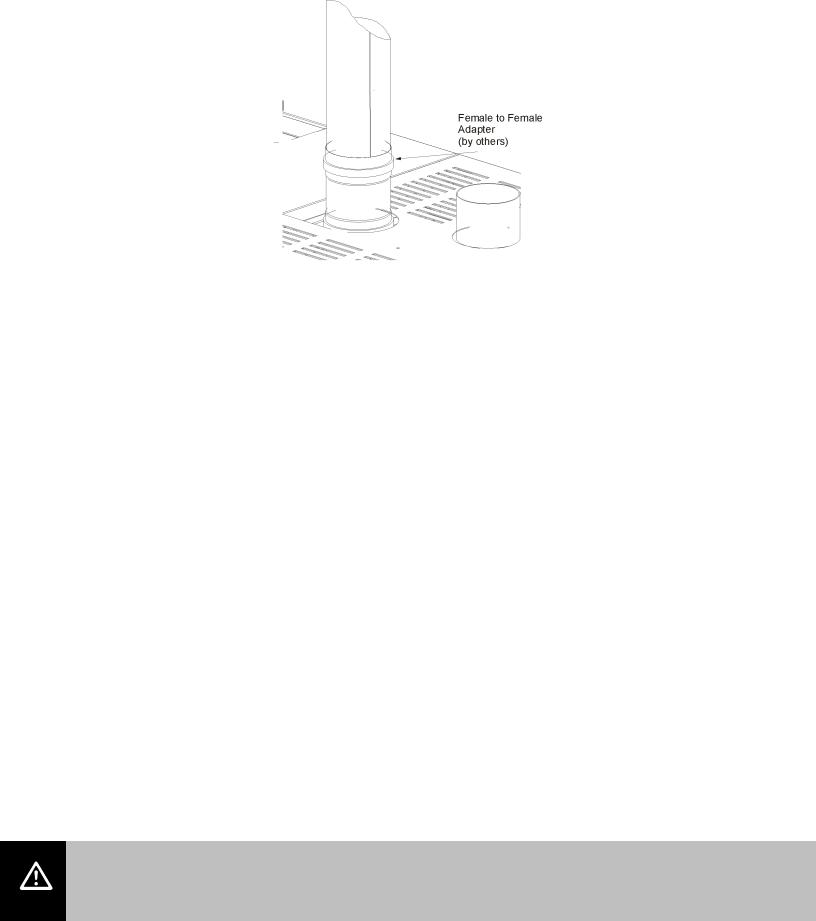
Figure 13: Exhaust Connection
Installation As A Category III Appliance
General
This venting system can be installed horizontally or vertically and can terminate on a rooftop or sidewall provided the NFGC (Nation Fuel Gas Code) and CAN/CGAB149 codes are followed. The venting manufacturer instructions must also be followed.
Venting must be UL or UL/CSA listed, tested to ULC-5636 standard. Venting may be BH, L vent or Special Gas Vent. The vent shall be listed and installed in accordance with the terms of the vent listing and the manufacturer’s instructions. The instructions listed below should be followed as well.
A minimum equivalent vent length of 7 feet must be connected to the humidifier. Vent lengths must not exceed 70’ (21 m). Each 90° elbow is equivalent to 10’ and each 45° elbow equals 5'. The vent run should be as direct as possible with no more than 6 elbows in the system. Contact nortec technical service if you have any questions
This category installation may not be common vented with any other natural draft gas appliance or power assist appliance. All joints must be sealed using high temperature rtv silicone.
The gas humidifier is supplied with the following exhaust outlets.
GS 100 |
3” |
GS 200 |
4” |
GS 300/400 |
5” |
GS 500/600 |
6” |
The venting must remain the same diameter throughout the installation. Horizontal BH type venting must be used in a direct vent application.
Warning:
Provide a screen or barrier to prevent personal injury in areas where inadvertent personnel contact with vent pipe can occur.
GS Series Installation | 18

BH Vent Manufacturers
Flex-l international
Fas-n seal
Heat-fab Inc.
Z flex
Warning:
Provide a screen or barrier to prevent personal injury in areas where inadvertent personnel contact with vent pipe can occur.
Additional requirements when venting through a sidewall.
For sidewall venting, locate the humidifier as close as possible to the wall being used.
Locate the vent terminal at least three feet above any forced air inlet located within ten feet; or at least four feet below, four feet horizontally from, or one foot above any door, window, or gravity air inlet into any building.
A minimum horizontal clearance of four feet from electric meters, gas meters, regulator and relief equipment is required.
For sidewall vent terminations, the humidifier must be installed with a certified vent terminal that can be purchased from Nortec.
GS 100 |
3” |
Nortec P/N 1502321 |
GS 200 |
4” |
Nortec P/N 1502322 |
GS 300/400 |
5” |
Nortec P/N 1507320 |
GS 500/600 |
6” |
Nortec P/N 1507321 |
Locate the vent terminal at least 7 feet or 2.1 m above grade from public walkways, adjacent buildings, operable windows and building openings, consistent with the National Fuel Gas Code ANSI Z223.1 and/or CSA B149.1 Installation codes.
Locate the bottom of the vent terminal at least twelve inches above grade or ground, or normally expected snow accumulation level. The snow level may be higher on walls exposed to prevailing winds.
Locate terminal at least 4 feet or 1.22 m from electric meter, gas meters, regulators, and relief equipment.
Avoid areas where local experience indicates that condensate drip may cause problems such as above planters, patios, or over public walkways, or over an area where condensate or vapor could create a nuisance or hazard, or could be detrimental to the operation of regulators, relief valves, or other equipment. Refer to the vent manufacturer's installation instructions.
The vent terminal must be installed in the same atmospheric pressure zone as the combustion air inlet of the humidifier. If this is not possible (as in cases of positive or negative room pressures) the humidifier should be installed with the sealed combustion or direct vent option.
19 | GS Series Installation

Electrical and Plumbing
Electrical
Primary Wiring
All work concerning the electrical installation must be performed by qualified personnel.
Warning:
The electrical parts inside the humidifier are very sensitive to electrostatic discharge. Appropriate measures against electrostatic discharge (esd protection) must be taken when carrying out installation work.
The humidifier should only be connected to primary power (main power) after all installation work has been completed.
An external disconnect switch must be installed close to the unit to allow for power interruption during servicing and/or maintenance.
Humidifiers require field wiring to primary voltage terminal blocks. Depending on the unit, power requirement must be 120 Vac or 208-240 Vac, 15 A, 20 A or 30 A separately fused circuit, single phase. See Table 4 for details. Use only copper wire with a minimum 70 °C (158 °F) temperature rating. Wiring can be fed through a 7/8" hole on the bottom or the top of the control compartment.
When installed, the appliance must be electrically grounded in accordance with local codes or, in the absence of local codes, with the National Electrical Code, ANSI/NFPA 70, and/or the CSA C22.1 Electrical Code, if an external electrical source is utilized.
External wiring sizes must be in accordance with NEC and/or CEC and existing local electrical codes and bylaws.
Low Voltage Control Wiring
All GS models require at least one type of input control signal for unit operation. Refer to the sections below that detail the types of controls that can be used with each model.
Low voltage control terminal strips are provided in the electrical compartment. Internal sides are factory wired. External sides are to be field wired. Refer to the specific control-wiring diagram supplied with each unit.
Field wiring from humidistat to humidifier and between devices should be shielded 18 AWG or heavier and kept as short as possible.
Controls are available from NORTEC as accessories and can be ordered with the humidifier. Controls by others may also be used as long as they meet the criteria noted below. The following is a summary of the common types of controls that may be used with NORTEC Gas Humidifiers.
Wall or Duct Mounted Control On/Off Humidistat: Wired to make on drop in humidity, break on rise to setpoint. Set to desired RH. Can be a make/break set of contacts from a Building Automation System.
Duct Mounted Safety High Limit On/Off Humidistat: Wired to make on drop in humidity, break on rise to safety setpoint. Set to approximately 85% RH as a safety to prevent saturation and wetting in the duct. Highly recommended for ducted applications.
Duct Mounted Safety Air Proving On/Off Switch: Wired to make when sensing air flow, break when no air flow. Used as a safety to prevent saturation when there is no air flow. Highly recommended for ducted applications.
GS Series Installation | 20

Wall or Duct Mounted Modulating Humidistat: Provides a modulating signal to the unit that represents the output (up to 100%) required from the humidifier. Signal type can be changed in the field.
All GS models may be configured for either single or dual channel modulation. Control signals can be 0-10 VDC or 0-20 mA (0-5 VDC, 1-5 VDC, 4-20 mA and 2-10 VDC are also available). The unit must be ordered from the factory for the desired signal type and number of channels. When configured for 2-channel modulation the humidifier will generate steam only if both channels indicate a demand. If both channels are demanding steam the humidifier will satisfy the lower demand signal.
|
|
Table 4: Current and Breaker Requirements for GS Series Units |
|||||||
|
|
|
|
|
|
|
|
|
|
|
|
|
|
|
Voltage (V) |
|
Rated Amps (A) |
|
Suggested Breaker (A) |
|
|
|
|
|
|
|
|
|
|
|
GSTC/GSP 100 Indoor |
|
|
120 |
|
2.1 |
|
15 |
|
|
|
|
|
|
|
|
|
|
|
|
|
|
|
208-240 |
|
1.1 |
|
15 |
|
|
|
|
|
|
|
|
|
||
|
GSTC/GSP 200 Indoor |
|
|
120 |
|
3.7 |
|
15 |
|
|
|
|
|
|
|
|
|
|
|
|
|
|
|
208-240 |
|
1.9 |
|
15 |
|
|
|
|
|
|
|
|
|
||
|
GSTC/GSP 300 Indoor |
|
|
120 |
|
5.3 |
|
15 |
|
|
|
|
|
|
|
|
|
|
|
|
|
|
|
208-240 |
|
2.7 |
|
15 |
|
|
|
|
|
|
|
|
|
||
|
GSTC/GSP 400 Indoor |
|
|
120 |
|
6.8 |
|
15 |
|
|
|
|
|
|
|
|
|
|
|
|
|
|
|
208-240 |
|
3.5 |
|
15 |
|
|
|
|
|
|
|
|
|
||
|
GSTC/GSP 500 Indoor |
|
|
120 |
|
8.4 |
|
15 |
|
|
|
|
|
|
|
|
|
|
|
|
|
|
|
208-240 |
|
4.3 |
|
15 |
|
|
|
|
|
|
|
|
|
||
|
GSTC/GSP 600 Indoor |
|
|
120 |
|
10 |
|
15 |
|
|
|
|
|
|
|
|
|
|
|
|
|
|
|
208-240 |
|
5.2 |
|
15 |
|
|
|
|
|
|
|
|
|
||
|
GSTC Outdoor 100 |
|
|
120 |
|
6.3 |
|
15 |
|
|
|
|
|
|
|
|
|
|
|
|
|
|
|
208-240 |
|
3.2 |
|
15 |
|
|
|
|
|
|
|
|
|||
|
GSTC Outdoor 200 |
|
|
120 |
|
7.4 |
|
15 |
|
|
|
|
|
|
|
|
|
|
|
|
|
|
|
208-240 |
|
4 |
|
15 |
|
|
|
|
|
|
|
|
|||
|
GSTC Outdoor 300 |
|
|
120 |
|
13.7 |
|
20 |
|
|
|
|
|
|
|
|
|
|
|
|
|
|
|
208-240 |
|
6.9 |
|
15 |
|
|
|
|
|
|
|
|
|||
|
GSTC Outdoor 400 |
|
|
120 |
|
15.2 |
|
20 |
|
|
|
|
|
|
|
|
|
|
|
|
|
|
|
208-240 |
|
7.7 |
|
15 |
|
|
|
|
|
|
|
|
|||
|
GSTC Outdoor 500 |
|
|
120 |
|
21 |
|
30 |
|
|
|
|
|
|
|
|
|
|
|
|
|
|
|
208-240 |
|
10.6 |
|
15 |
|
|
|
|
|
|
|
|
|
||
|
GSTC Outdoor 600 |
|
|
120 |
|
22.6 |
|
30 |
|
|
|
|
|
|
|
|
|
|
|
|
|
|
|
208-240 |
|
11.5 |
|
15 |
|
|
|
|
|
|
|
|
|
|
|
21 | GS Series Installation
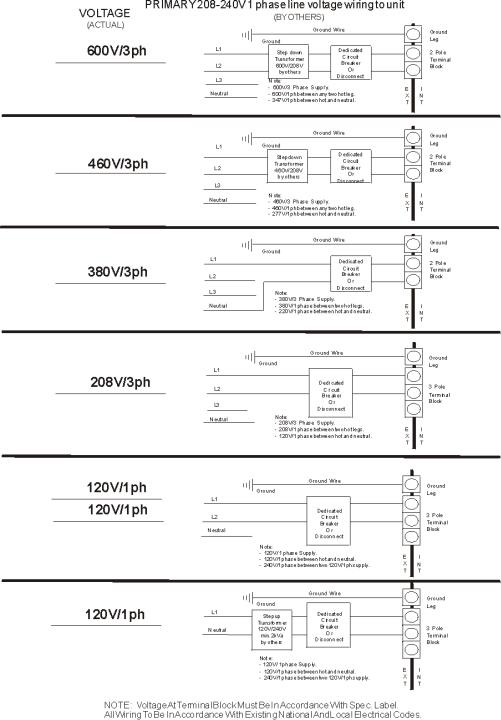
Figure 14: Primary 208-240 V 1 Phase Line Voltage Wiring To Unit
GS Series Installation | 22

NORTEC SERIES
EXTERNAL CONTROLS WIRING CONNECTIONS
LOW VOLTAGE TERMINAL STRIP
For all controller and transducer signals by others
WARNING: Fai lure to wi re t he c ont roll er i n acc orda nce wit h t he wi ring dia gram suppli ed w it h the unit coul d perma ne ntl y dam age t he e le ct roni cs . Such errors wi l l void t he uni t warrant y.
POWER TO CONTROLLER OR
TRANSDUCER BY OTHERS
Both inputs to the |
|
|
|
|
|
|
|||
|
Single |
|
Dual |
||||||
humidifier must be |
|
|
|||||||
|
Signal |
|
Signal |
||||||
the same type of |
|
|
|||||||
|
Input |
|
Input |
||||||
signal |
_ "1” |
_ "2” |
|||||||
|
|
|
|
||||||
Security Loop |
+ |
+ |
|||||||
24Vac |
|
|
|||||||
|
|
||||||||
|
|
|
|
|
|
|
|
|
|
Other On / Off
Device
Blower
Pack
High Limit
Humidistat
Air Proving |
Vac24 |
Vdc5 |
|
Switch |
|
On/Off Control |
|
Humidistat |
|
EXTERNAL |
1 |
2 |
3 |
4 |
5 |
6 |
7 |
8 |
EXTERNAL |
INTERNAL |
INTERNAL |
||||||||
|
|
|
|
+ + |
|
|
|
|
|
Transducers:
To be complete with sensing element, power source and
2 wire varying output signal. RH set point adjustment
is made at unit keypad. RH set point and % RH
sensed are viewed on display
Output signal across
3 - 4 and 3 - 5 increase on RH rise
Controllers (Humidistat):
To be complete with RH set point adjustment, sensor circuit,
sensing element, power source and
2 wire varying output signal. RH demand are viewed on display
Output signal across
3 - 4 and 3 - 5 decrease on RH rise
NOTE: If no On/Off Control is used then a field jumper must be connected across terminals 1 and 2 in order for the humidifier to operate.
Terminal 8 is a 24Vac input. Upon receiving 24Vac a full tank blowdown will be initiated
NORTEC SERIES
EXTERNAL CONTROLS WIRING CONNECTIONS
LOW VOLTAGE TERMINAL STRIPS
May 27 2008
- www.humidity.com -
Figure 15: GS Series External Controls and Wiring Connections Low Voltage Terminal Strip
23 | GS Series Installation
Control Installation
Mount any wall humidistat (control or high limit) over standard electrical box at height similar to typical thermostat. Any wall humidistat should be in location representative of overall space being humidified and not in path of blower pack or air supply grill. Do not mount on an outside wall where temperature fluctuations can affect control response.
Mount duct humidistat in location representative of overall air humidity, usually in return duct. Do not mount it directly in front of steam distributor or in turbulent or mixing zone. Mount humidistat where air's humidity and temperature are uniform and representative of spaces being humidified.
Mount duct high limit humidistat downstream of steam distributors far enough that, under normal humidity and air flow conditions, steam will have been fully absorbed (typically at least 10 feet). It must be located to sense high humidity only when uniform and representative air is over-humidified or approaching saturation.
Mount duct air-proving switch so that it is able to sense air flow or lack of it. Wire it to make when air flow is sensed and break when air flow fails.
Check operation of all on/off controls before starting humidifier.
Calibration of controls (on/off or modulation) in the field may be necessary due to shipping and handling. Verify humidistat accuracy before commissioning system.
GS Series Installation | 24
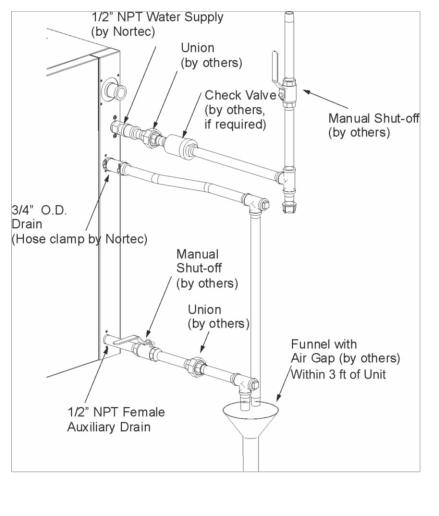
Plumbing
Note: All water supply and drain line connections should be installed in accordance with local plumbing codes.
Fill Water Supply Line
Each unit is supplied with an adapter for the fill valve (½”NPT). Fill rate 10 l/min all unit sizes. Size of piping is a minimum ½” copper; recommend ¾” up to within 4 feet of unit.
Standard fill valves are sized for water pressure ranging from 30 to 80 psig (ideally 55 to 60 psig). For other pressures, consult factory. This pressure should be measured at the humidifier if the water pressure is suspect.
It is recommended to have a faucet installed close to the humidifier to allow quick filling of the system on initial start up. This can also be very useful for mandatory cleaning of the unit.
ALWAYS supply and install a shut off valve and union in the water supply line dedicated to the humidifier to facilitate servicing.
If water hammer occurs, install a shock arrester on the fill water line just before the inlet to the fill valve. Water hammer will damage the fill valve.
A 1” air gap is designed into the fill system of the GS humidifier. Some local plumbing codes may still require the installation of a double check valve on the fill line to the humidifier to prevent contamination of the supply water system. Verify with local codes and install if necessary.
Figure 16: Plumbing Connections
25 | GS Series Installation
Drain Line
The humidifier is equipped with a ¾”O.D. unthreaded drain outlet connection on the side of the humidifier. A vacuum break valve is installed internal to the unit on the drain line. The drain water line must be piped to a drain funnel to provide an air gap before connection to the building drainage system.
The air gap must be within 3 ft (1 m) of the humidifier.
The drain line should not end in a sink used frequently by personnel, or where plumbing codes prohibit it. Route to a floor drain or equivalent for safety reasons. Internal drain water tempering will ensure a maximum of 140ºF (60ºC) exiting water temperature.
Never install PVC piping as a drain line material. Always use material suitable for with-standing 140ºF (60ºC).
Keep drain lines as short as possible. Keep drain lines sloped down, not level and not up since low spots in drain lines will accumulate sediment and cause backup. The drain line should be 1-1.5" O.D. or larger. Consult local codes.
When the drain pump is activated, the tank drains at a rate of 4.5-5.3 gal/min (18-20 l/min).
Aux Drain Port
An auxiliary drain port is also provided on the side of the humidifier. It can be used to manually drain the unit, if required. The unit is shipped with this connection plugged. It is recommended to install a shut off valve on this line (see Figure 16).
The auxiliary drain port is used with the standard freeze protection on Outdoor units. Install a shut off valve on this line and pipe to the drain funnel (see Figure 16). The manual shut off valve must always be in the open position when the unit is operating but can be closed for servicing of the unit.
Steam Lines and Condensate Line
Steam hoses and clamps are provided with the GS humidifier for connection to the steam lines. Refer to Figure 17 for connection details.
For steam line installation between the humidifier and distribution system, consult the distribution system installation manual. Steam Distributor Installation Manual. See Table 5: Steam Line Sizing for details on the sizing and lengths of steam lines.
The GS Series of Gas-Steam humidifiers can develop steam pressures up to 12”w.c. to overcome duct and steam line pressures. An enclosed trap on the drain line prevents steam from going to drain. Duct pressures above 12” will cause steam to exits through the drain line. Consult factory.
GS Series Installation | 26
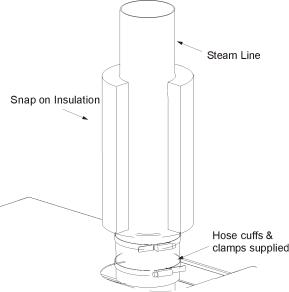
Figure 17: Steam Line Connection
Table 5: Steam Line Sizing
|
|
Steam |
|
|
|
|
Steam loss per foot |
|
|
|
|
|
MED-L copper tube |
Stainless steel tube |
|
|
Steam line |
||
Humidifier |
|
output |
|
nominal steam |
diameter (wall |
|
in condensation |
|
maximum |
|
|
[ lb ] |
|
line size |
thickness 0.065”) |
|
[ lb/ft ] |
|
equivalent length |
|
|
|
|
|
|
|
|
|
|
GS 100 |
100 |
|
1-1/2” |
1-3/4” |
0.11 |
|
90 ft |
||
|
|
|
|
|
|
|
|
||
GS 200 |
200 |
|
3” |
3” |
0.16 |
|
90 ft |
||
|
|
|
|
|
|
|
|
||
GS 300 |
300 |
|
3” |
3” |
0.16 |
|
180 ft |
||
|
|
|
|
|
|
|
|
||
GS 400 |
400 |
|
4” |
4” |
0.22 |
|
180 ft |
||
|
|
|
|
|
|
|
|
||
GS 500 |
500 |
|
4” |
4” |
0.22 |
|
220 ft |
||
|
|
|
|
|
|
|
|
||
GS 600 |
600 |
|
4” |
4” |
0.22 |
|
260 ft |
||
|
|
|
|
|
|
|
|
|
|
•Based on 3” duct static pressure, Maximum duct static pressure for GS is 12” w.c.
Table 6: Effective Lengths of Typical Steam-Line Fittings
|
Nominal tube |
|
|
Standard |
|
|
Standard |
|
|
Side-outlet |
|
|
Gate valve* |
|
|
Globe valve* |
|
|
|
|
|
|
|
|
|
|
|
|
|
||||||
|
size |
|
|
|
|
|
|
|
|
tee |
|
|
|
|
|
||
|
|
|
90°-elbow |
|
|
45°-elbow |
|
|
|||||||||
|
|
|
|
|
|
|
|
|
|
|
|
|
|
||||
|
|
|
|
|
|
|
|
|
|
|
|
|
|
||||
|
1-1/2” |
|
|
3.5 ft |
|
|
1.75 ft |
|
|
7 ft |
|
|
0.8 ft |
|
34 ft |
||
|
|
|
|
|
|
|
|
|
|
|
|
|
|
|
|
||
|
1- 3/4” |
|
|
3.5 ft |
|
|
1.75 ft |
|
|
7 ft |
|
|
0.8 ft |
|
34 ft |
||
|
|
|
|
|
|
|
|
|
|
|
|
|
|
|
|
||
|
3” |
|
|
5 ft |
|
|
2.5 ft |
|
|
11 ft |
|
|
1.1 ft |
|
54 ft |
||
|
|
|
|
|
|
|
|
|
|
|
|
|
|
|
|
||
|
4” |
|
|
8 ft |
|
|
4 ft |
|
|
15 ft |
|
|
1.6 ft |
|
80 ft |
||
|
|
|
|
|
|
|
|
|
|
|
|
|
|
|
|
|
|
*Valve in full open position.
27 | GS Series Installation
